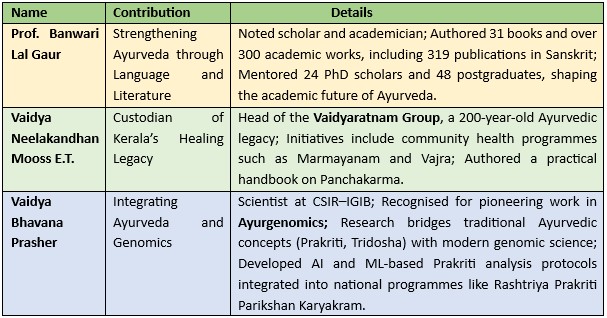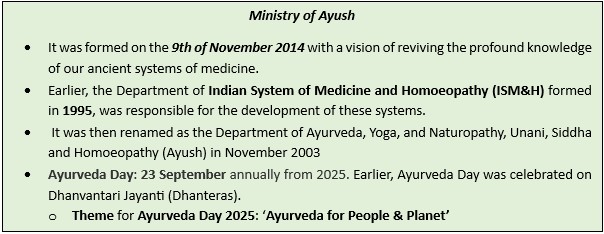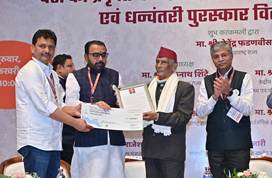Context: The Ministry of AYUSH conferred the National Dhanwantari Ayurveda Awards 2025, to honour individuals who have made outstanding contributions for Advancing Ayurveda through Education, Traditional Knowledge, and Research.
- The 2025 awardees represent three vital dimensions of Ayurveda: Classical scholarship, Living traditional practice, and Scientific innovation.
Recipients:

About Ayush system of Medicine:
It is the acronym of the medical systems that are being practiced in India such as Ayurveda, Yoga & Naturopathy, Unani, Siddha and Homeopathy.
- Ayurveda: It is an indigenous ancient medical science of India, is more than 5000 years old. It is considered to be an upveda of Atharva Veda.
- Mention of use of herbs for medicinal purpose is found in the oldest available written literature of world, Rigveda.
- Yoga: Maharishi Patanjali is considered Father of Yoga.
- There are eight steps of yoga called “Ashtang Yoga”. The steps are: Yama (restraints), Niyama (observances), Asana (Physical postures), Pranayama (Control of breathing), Pratyahara (withdrawal from the worldly objects), Dharana (concentration), Dhyana (Meditation) and Samadhi (integration of mind and body).
- Naturopathy has been greatly advocated by Father of Nation Mahatma Gandhi.
- Naturopathy encompasses all proven drugless therapies and offers a holistic health care approach without the use of chemical or herbal medicines.
- Unani: It is one of the oldest systems of medicine, based on the teachings of Hippocrates (Father of Medicine) in 460 BC.
- It was introduced by Arabs into Indian subcontinent
- Siddha: Siddha literature is in Tamil and is practised largely in Tamil speaking parts of India and abroad.
- According to this syatem, the human body is the replica of the Universe and so are the foods and drugs irrespective of their origin.
- Homoeopathy: It was introduced by Samuel Hahnemann (1755-1843), a renowned German Physician.
- It is a system of individualistic drug therapeutics, based on well proved scientific principles, especially the Law of Similars.


